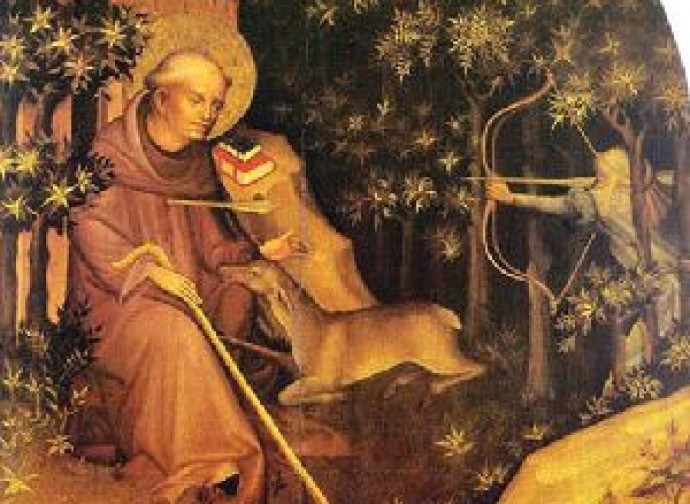Saint Giles (abbot)
Saint Giles (Aegidius) (c. 640 - c. 720) was a hermit and abbot. According to the Vita sancti Aegidii (dating back to the 10th century) he was born in Athens and moved to France, where he is mainly referred to as Saint Gilles. He settled in the southern part of France, spending his days in prayer and contemplation.

He is invoked for multiple needs, including a good confession. Saint Giles (Aegidius) (c. 640 - c. 720) was a hermit and abbot. According to the Vita sancti Aegidii (dating back to the 10th century) he was born in Athens and moved to France, where he is mainly referred to as Saint Gilles. He settled in the southern part of France, spending his days in prayer and contemplation of God in refuges not far from the courses of the Rhone and Gardon.
The hagiographic tradition, which became richer after his first Life, recounts that the saint had as his only companion a hind that fed him with her milk. One day the king of the Visigoths, Wamba (†688), went hunting in the forest where Giles lived and shot an arrow in the direction of the hind, which was about to take refuge in the cave where the saint sheltered. The dart ended up hitting Giles himself, who was injured in the leg. As soon as the king realized the fact, he apologized deeply to the good hermit and offered him that land to build a monastery.
Giles initially declined the offer partly because he wanted to live in solitude. But over time his reputation for holiness attracted a multitude of people who went to visit him and in the end, around 674, Wamba had a monastery built. The saint became its first abbot. Around the religious building a small town developed, today known as Saint-Gilles-du-Gard, where one can admire the splendid abbey church dedicated to him, built above the crypt with his Merovingian-style tomb. In the late Middle Ages, the tomb of St Giles became the destination of great pilgrimages because both the faithful on their way to Rome and those who walked the Way of St James stopped there.
Tradition also reports that during his time as abbot he was begged by Charles Martel (c. 688-741) to pray for forgiveness for a sin that he had never wanted to confess to anyone out of shame. The saint prayed intensely for him and, while he was celebrating Mass, he saw an angel in the act of placing a parchment on the altar on which Charles Martel's grave sin had been written, which gradually faded as the Eucharistic celebration unfolded. Giles probably died on 1 September 720 or 721 and his cult soon spread to many regions of Europe, as the many villages, churches and monasteries named after him testify. His name was included among the 14 “Auxiliary Saints” and he is the only one who is not a martyr.
Patron of: breastfeeding, good confession, the disabled, sterile women, epileptics, hermits, lepers, mothers, cancer and AIDS patients, beggars; invoked against nervous diseases and panic.




